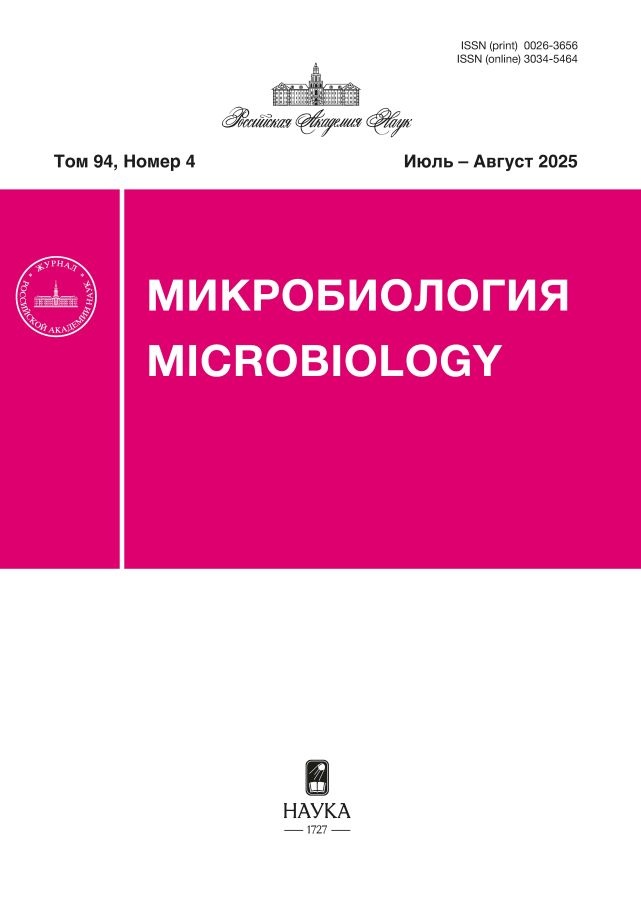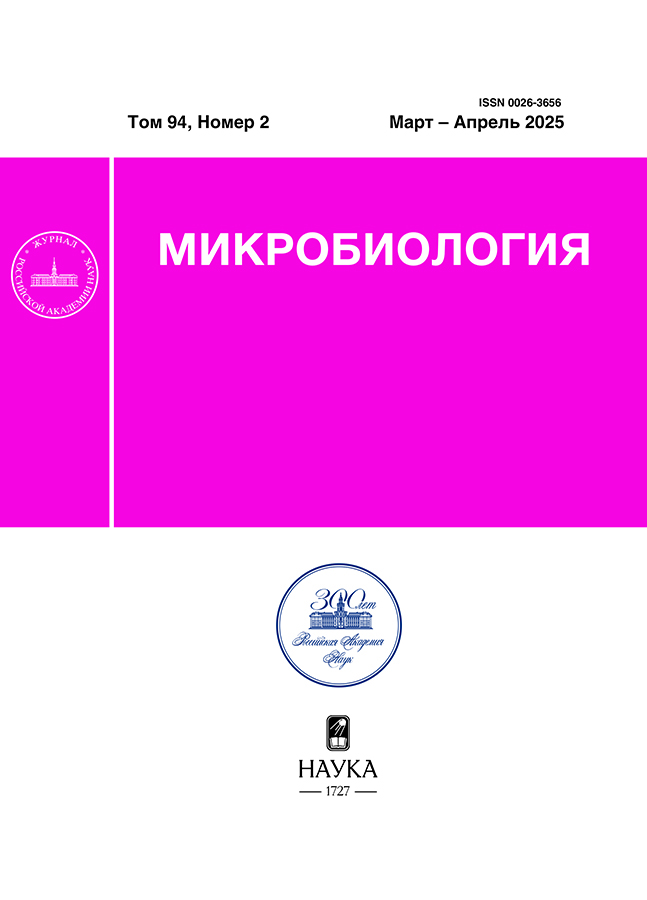Новые штаммы микромицетов с кератинолитической активностью
- Авторы: Тиморшина С.Н.1, Ганецкая Е.А.1, Шестакова А.А.1,2, Лямина В.М.1, Александрова А.В.1, Попова Е.А.1, Адманова Г.Б.3, Осмоловский А.А.1
-
Учреждения:
- Московский государственный университет имени М.В. Ломоносова
- НИУ “Высшая школа экономики”
- Актюбинский региональный университет им. К. Жубанова
- Выпуск: Том 94, № 2 (2025)
- Страницы: 132–144
- Раздел: ЭКСПЕРИМЕНТАЛЬНЫЕ СТАТЬИ
- URL: https://jdigitaldiagnostics.com/0026-3656/article/view/680835
- DOI: https://doi.org/10.31857/S0026365625020029
- ID: 680835
Цитировать
Полный текст
Аннотация
Впервые показана способность микромицета Tolypocladium inflatum синтезировать кератинолитические ферменты. 22 штамма микромицетов, выделенных из накопительных культур кератинолитических микроорганизмов, относились к родам Aspergillus, Cladosporium, Fusarium, Keratinophyton, Penicillium, Pseudallеscheria, Tolypocladium и Trichoderma. Только два штамма показали высокую кератинолитическую активность при глубинном культивировании – Keratinophyton terreum С106 (74.2 Е) и Tolypocladium inflatum ST1 (87.1 Е). Целевая активность K. terreum в глубинной культуре снижалась практически до нуля уже к 7 сут культивирования, тогда как активность T. inflatum снижалась менее, чем на 20%. У T. inflatum была выделена внеклеточная протеаза с кератинолитической активностью, pI около 5.6 и молекулярной массой около 31 кДа.
Ключевые слова
Полный текст
Об авторах
С. Н. Тиморшина
Московский государственный университет имени М.В. Ломоносова
Автор, ответственный за переписку.
Email: timorshina.svetlana@mail.ru
Россия, Москва, 119234
Е. А. Ганецкая
Московский государственный университет имени М.В. Ломоносова
Email: timorshina.svetlana@mail.ru
Россия, Москва, 119234
А. А. Шестакова
Московский государственный университет имени М.В. Ломоносова; НИУ “Высшая школа экономики”
Email: timorshina.svetlana@mail.ru
Россия, Москва, 119234; Москва, 101000
В. М. Лямина
Московский государственный университет имени М.В. Ломоносова
Email: timorshina.svetlana@mail.ru
Россия, Москва, 119234
А. В. Александрова
Московский государственный университет имени М.В. Ломоносова
Email: timorshina.svetlana@mail.ru
Россия, Москва, 119234
Е. А. Попова
Московский государственный университет имени М.В. Ломоносова
Email: timorshina.svetlana@mail.ru
Россия, Москва, 119234
Г. Б. Адманова
Актюбинский региональный университет им. К. Жубанова
Email: timorshina.svetlana@mail.ru
Казахстан, Актобе, 030000
А. А. Осмоловский
Московский государственный университет имени М.В. Ломоносова
Email: timorshina.svetlana@mail.ru
Россия, Москва, 119234
Список литературы
- Фокичев Н. С., Корниенко Е. И., Крейер В. Г., Шаркова Т. С., Осмоловский А. А. Тромболитический потенциал и свойства протеиназ – активаторов плазминогена, образуемых микромицетом Тolypocladium inflatum k1 // Микология и фитопатология. 2021. Т. 55. № 6. С. 446–452.
- Barrios-González J., Tarragó-Castellanos M. R. Solid-state fermentation: special physiology of fungi // Fungal metabolites. Reference series in phytochemistry / Eds. Mérillon J. M., Ramawat K. Cham: Springer, 2017. P. 319–347. https://doi.org/10.1007/978-3-319-25001-4_6
- Bensch K., Braun U., Groenewald J. Z., Crous P. W. The genus Cladosporium // Stud. Mycol. 2012. V. 72. P. 1–401.
- Bhari R., Kaur M. Fungal keratinases: enzymes with immense biotechnological potential // Fungal resources for sustainable economy / Eds. Singh I., Rajpal V. R., Navi S. S. Singapore: Springer, 2023. P. 89–125. https://doi.org/10.1007/978-981-19-9103-5_4
- Carbone I., Kohn L. M. A method for designing primer sets for speciation studies in filamentous Ascomycetes // Mycologia. 1999. V. 91. P. 553–556. https://doi.org/10.2307/3761358
- Crous P. W., Lombard L., Sandoval-Denis M., Seifert K. A., Schroers H. J., Chaverri P., Thines M. Fusarium: more than a node or a foot-shaped basal cell // Stud. Mycol. 2021. V. 98. Art. 100116.
- de Menezes C. L.A., Santos R. D.C., Santos M. V., Boscolo M., da Silva R., Gomes E., da Silva R. R. Industrial sustainability of microbial keratinases: production and potential applications // World J. Microbiol. Biotechnol. 2021. V. 37. Art. 86. https://doi.org/10.1007/s11274-021-03052-z
- de Souza P. M., Bittencourt M. L., Caprara C. C., de Freitas M., de Almeida R. P., Silveira D., Fonseca Y. M., Ferreira Filho E. X., Pessoa Junior A., Magalhães P. O. A biotechnology perspective of fungal proteases // Braz. J. Microbiol. 2015. V. 46. P. 337–346. https://doi.org/10.1590/S1517-838246220140359
- Dong Q. Y., Wang Y., Wang Z. Q., Liu Y. F., Yu H. Phylogeny and systematics of the genus Tolypocladium (Ophiocordycipitaceae, Hypocreales) // J. Fungi. 2022. V. 8. Art. 1158.
- El-Gendi H., Saleh A. K., Badierah R., Redwan E. M., El-Maradny Y.A., El-Fakharany E.M. A comprehensive insight into fungal enzymes: structure, classification, and their role in mankind’s challenges // J. Fungi (Basel). 2021. V. 8. Art. 23. https://doi.org/10.3390/jof8010023
- Evans K. L., Crowder J., Miller E. S. Subtilisins of Bacillus spp. hydrolyze keratin and allow growth on feathers // Can. J. Microbiol. 2000. V. 46. P. 1004–1011. https://doi.org/10.1139/w00-085
- Fang Z., Yong Y. C., Zhang J., Du G., Chen J. Keratinolytic protease: a green biocatalyst for leather industry // Appl. Microbiol. Biotechnol. 2017. V. 101. P. 7771–7779. https://doi.org/10.1007/s00253-017-8484-1
- Fokichev N. S., Kokaeva L. Yu., Popova E. A., Kurakov A. V., Osmolovskiy A. A. Thrombolytic Potential of micromycetes from the genus Tolypocladium, obtained from White Sea soils: screening of producers and exoproteinases properties // Microbiol. Res. 2022. V. 13. P. 898–908. https://doi.org/10.3390/microbiolres13040063
- Food and indoor fungi. CBS Laboratory manual series 2 / Eds. Samson R. A., Houbraken J., Thrane U., Frisvad J. C., Andersen B. Utrecht, Netherlands: CBS-KNAW Fungal Biodiversity Centre, 2010. 390 p.
- Fungal biodiversity. CBS Laboratory manual series 1 / Eds. Crous P. W., Verkley G. J.M., Groenewald J. Z., Samson R. A. Utrecht, Netherlands: CBS-KNAW Fungal Biodiversity Centre, 2009. 270 p.
- Glass N. L., Donaldson G. C. Development of primer sets designed for use with the PCR to amplify conserved genes from filamentous ascomycetes // Appl. Environ. Microbiol. 1995. V. 61. P. 1323–1330. https://doi.org/10.1128/aem.61.4.1323-1330.1995
- Houbraken J., Frisvad J. C., Samson R. A. Taxonomy of Penicillium section Citrina // Stud. Mycol. 2011. V. 70. P. 53–138.
- Kanth S. V., Venba R., Madhan B., Chandrababu N. K., Sadulla S. Studies on the influence of bacterial collagenase in leather dyeing // Dye Pigment. 2008. V. 76. P. 338–347.
- Khosravi A. R., Mahdavi Omran S., Shokri H., Lotfi A., Moosavi Z. Importance of elastase production in development of invasive aspergillosis // J. Mycol. Med. 2012. V. 22. P. 167–172. https://doi.org/10.1016/j.mycmed.2012.03.002
- Kothary M. H., Chase Jr. T., Macmillan J. D. Correlation of elastase production by some strains of Aspergillus fumigatus with ability to cause pulmonary invasive aspergillosis in mice // Infect. Immun. 1984. V. 43. P. 320–325. https://doi.org/10.1128/iai.43.1.320‐325.1984
- Kumar S., Stecher G., Li M., Knyaz C., Tamura K. MEGA X: Molecular Evolutionary Genetics Analysis across computing platforms // Mol. Biol. Evol. 2018. V. 35. P. 1547–1549. https://doi.org/10.1093/molbev/msy096
- Kurtzman C. P., Robnett C. J. Identification and phylogeny of ascomycetous yeasts from analysis of nuclear large subunit (26S) ribosomal DNA partial sequences // Antonie van Leeuwenhoek. 1998. V. 73. P. 331–371. https://doi.org/10.1023/A:1001761008817
- Labuda R., Bernreiter A., Hochenauer D., Kubátová A., Kandemir H., Schüller C. Molecular systematics of Keratinophyton: the inclusion of species formerly referred to Chrysosporium and description of four new species // IMA Fungus. 2021. V. 12. Art. 17. https://doi.org/10.1186/s43008-021-00070-2
- Oda K., Kakizono D., Yamada O., Iefuji H., Akita O., Iwashita K. Proteomic analysis of extracellular proteins from Aspergillus oryzae grown under submerged and solid-state culture conditions // Appl. Environ. Microbiol. 2006. V. 72. P. 3448–3457. https://doi.org/10.1128/AEM.72.5.3448-3457.2006
- Qiu J., Wilkens C., Barrett K., Meyer A. S. Microbial enzymes catalyzing keratin degradation: classification, structure, function // Biotechnol. Adv. 2020. V. 44. Art. 107607. https://doi.org/10.1016/j.biotechadv.2020.107607
- Shestakova A., Lyamina V., Timorshina S., Osmolovskiy A. Patented keratinolytic enzymes for industrial application: an overview // Recent Pat. Biotechnol. 2023. V. 17. Р. 346–363. https://doi.org/10.2174/1872208317666221212122656
- Tamura Y., Suzuki S., Sawada T. Role of elastase as a virulence factor in experimental Pseudomonas aeruginosa infection in mice // Microb. Pathog. 1992. V. 12. P. 237–244. https://doi.org/10.1016/0882‐401090058‐v
- White T. J., Bruns T., Lee S. J.W.T., Taylor J. L. Amplification and direct sequencing of fungal ribosomal RNA genes for phylogenetics // PCR Protocols: a guide to methods and applications. AP, 1990 .V. 18. № 1. P. 315–322.
Дополнительные файлы

















